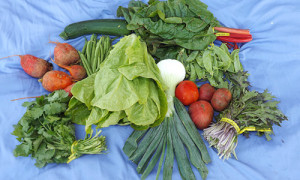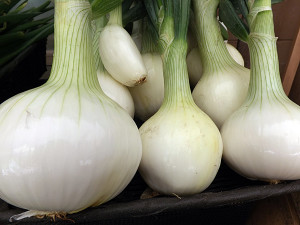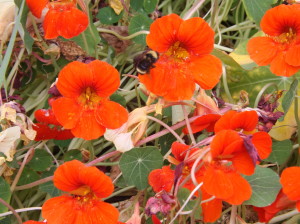Week 3, July 25: Both boxes have: A Walla Walla sweet onion, red chard, mizuna, cilantro, and Nash’s red kale plant starts.
The Small box also has: Heirloom tomatoes, green beans
The Standard box also has: Golden beets, zucchini,
lettuce, snow peas

Great Ways to Use Walla Walla Sweet Onions
The sweetness of the Walla Walla onion is due to its low sulfur content, rather than more sugar. Onions are an excellent source of chromium, vitamin C and B6, and a good source of dietary fiber and a number of flavonoids. The sulfur compounds, chromium and B6 work together to lower blood pressure and reduce the risk of heart disease and stroke. Onions also help in the maintenance of healthy bones.

Here are some ideas on how to use your Walla Walla Sweet Onion:
Grilled Sweet Onions—Peel and cut onions crosswise into thick slices or into medium-sized chunks. Toss or brush with olive oil, then skewer and grill! Sprinkle with salt or drizzle with sherry or red vinegar and serve with thick slices of raw tomato or other grilled goodies.
Roasted Sweet Onions—Peel the sweet onions, toss them with olive or vegetable oil to coat, sprinkle them with S&P and roast at 375°F until browned and tender, about 30 minutes. Combine with radishes, cauliflower, broccoli or other summer roastables. Leftovers are great with eggs or on cold salads.
Slow Cooked with Ham Hock—Chop a huge onion into the crock pot, add two cups of dried beans and a ham hock, cover with water about two inches above veg/beans, and simmer on low or med heat for 6-8 hours, or until everything is cooked and tender! You can also add spices and fresh herbs, a can of tomatoes, or additional veggies.
Sweet Onion & Avocado Salad—Peel and chop Walla Walla and 2 avocados. Drizzle with olive oil, a splash of lemon/lime juice, fresh cilantro, dash of ground cumin/cayenne, and salt to taste. Chopped radish, cucumber, sweet corn kernels, or chopped red pepper all make excellent additions.
Sweet Onion Raita (Yogurt Salad)—Peel and finely chop onion. Add enough plain yogurt to coat onions, and season with salt and pepper. Add freshly chopped dill, parsley, mint, and/or cilantro. Serve with grilled meats or salmon.
Sweet Onion Rings—Cut onions into thick slices and separate into rings. Dip in buttermilk and dredge in flour seasoned with salt, pepper, and a bit of cayenne. Heat an inch or two of vegetable or organic canola oil in a large, heavy pot until oil is about 350°F. Fry onions rings until golden brown, drain, and season with more salt.
Sweet Onion Sandwiches—Spread two slices of bread (dark rye is best) with mayonnaise. Sprinkle each side with chopped parsley or basil, if you like. Place a thick slice of sweet onion on one slice, top with a thick slice of tomato, sprinkle with salt and freshly ground black pepper, and close sandwich with second piece of bread or go open-face.
Sweet Onion Taco & Enchilada Topping—Peel and finely chop a sweet onion. Toss with fresh lime juice, add a generous amount of finely chopped cilantro, and season to taste with salt. Use to top tacos and enchiladas.
Sweet Onion Tossed Salad—Sweet onions are a mild addition to your favorite tossed green salad. They match particularly well with mild Boston lettuce or butter lettuce leaves, cucumber, carrots, and radishes.
Onion Egg Scramble—Saute chopped onion on med-high heat until they begin to soften and are caramel colored. Crack egg into pan, season with fresh herbs and S&P, scramble until cooked and enjoy atop a bed of quinoa or favorite toast.
Colleen, one of our subscribers, sent us this great sweet onion sandwich idea: “Just wanted to share one from my childhood created by my father Bill, (a possible peanut butter addict).
Walla Walla Sweet Sandwich—2 lightly toasted slices of hearty bread, one side smeared with peanut butter the other with mayo, a thick slice of Walla Walla Sweet. Optional additions: fresh lettuce or sprouts.”
About Mizuna
Mizuna is a leafy Japanese vegetable that is used in a Japanese soup called nabemono. The taste is a combination of bitter and peppery. Mizuna can be stir-fried, pickled, eaten in salads, or added to sandwiches.
Chop mizuna roughly and sauté it with boiled new potatoes, olive oil, salt and pepper for 3-5 minutes. This really mellows out the spicy greens but still allows the flavor to shine through.
For an excellent mizuna salad, toss together
1 Tbsp. olive oil
1.5 tsp. fresh lemon juice
1 tsp. minced Walla Walla onion
1/4 tsp. salt
1/2 bunch mizuna, trimmed, and roughly chopped
This goes really well with sliced spicy beef.




